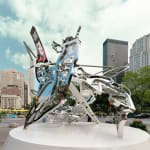Tomokazu Matsuyama Japan, b. 1976
335.3 x 396.2 x 396.2 cm
Further images
-
(View a larger image of thumbnail 1
)

-
(View a larger image of thumbnail 2
)

-
(View a larger image of thumbnail 3
)

-
(View a larger image of thumbnail 4
)

-
(View a larger image of thumbnail 5
)

-
(View a larger image of thumbnail 6
)

-
(View a larger image of thumbnail 7
)

-
(View a larger image of thumbnail 8
)

-
(View a larger image of thumbnail 9
)

-
(View a larger image of thumbnail 10
)

-
(View a larger image of thumbnail 11
)

-
(View a larger image of thumbnail 12
)

-
(View a larger image of thumbnail 13
)

Matsuyama placed these two forms in the same space as an expression of how dancing and running are separate activities that nonetheless express similar human interests. Dancing is more prevalent in Eastern Culture, while running is more a part of Western culture. Nonetheless both activities allow people to express similar human ideals.
Matsuyama’s sculptural practice is informed by his process of questioning how his imagery might be experienced by viewers in three-dimensional space. He contemplates the total optical experience of his paintings and the logical relationships of the formal elements within them, creating mirrored forms and patterns that serve as an optical metaphor for his vision of cultural exchange and influence. The effect event extends beyond the piece, as its surfaces will take on the colors of its environment.
The uncanny process of recognizing the unfamiliar plays out in the presence of Matsuyama’s sculptures. Simultaneously familiar and alien, they hint exquisitely at the worlds we know, not from life but from a dream. Hand welded from sheets of stainless steel and hand buffed to a mirror shine, these fragmented, labyrinthine forms are frozen in gestures that, again, relate to the “global us.” One, Matsuyama says, is a runner; another, a dancer. “Jogging is part of the Western experience. Dancing originates with Eastern culture. Both keep us mentally and physically connected,” he says.
In their distorted, curvilinear surfaces we see ourselves and wonder, like a glimpse into the Matrix, which side of the mirror is real.
That curiosity is essential to Matsuyama’s practice, as he invites us into an ever-evolving, global cultural conversation across a complex web of memories, visual languages, histories, dreams, and expectations.
This is seen dramatically with his Shinjuku Station installation Hanao-san, around which Matsuyama painted the ground with broad swaths of color to be reflected up onto the piece, or with the Meiji Shrine installation of Wheels of Fortune, which nearly camouflaged the piece, reflecting the complexity of nature across its perfect industrial surfaces. The works taking on their environments actively feels analogous to the way in which a person absorbs the culture around them, and perhaps in a hyper-literal sense is an optical illustration of how an artwork is affected by the context of its presentation.
Exhibitions
Tomokazu Matsuyama: The Best Part About Us, 2022. Kavi Gupta | Elizabeth St, Chicago, IL, USAArmory Off-Site, 2022. New York, NY, USA.
Tomokazu Matsuyama: Fictional Landscape, 2023. Hirosaki Museum of Contemporary Art, Hirosaki, Aomori, Japan.












